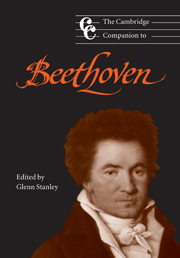Book contents
- Frontmatter
- Part I A professional portrait
- Part II Style and structure
- 4 “The spirit of Mozart from Haydn's hands”: Beethoven's musical inheritance
- 5 Phrase, period, theme
- 6 “The sense of an ending”: goal-directedness in Beethoven's music
- Part III Genres
- Part IV Reception
- Notes
- Selected further reading
- General index
- Index of Beethoven’s compositions and sketches
- Plate section
5 - Phrase, period, theme
from Part II - Style and structure
Published online by Cambridge University Press: 28 September 2011
- Frontmatter
- Part I A professional portrait
- Part II Style and structure
- 4 “The spirit of Mozart from Haydn's hands”: Beethoven's musical inheritance
- 5 Phrase, period, theme
- 6 “The sense of an ending”: goal-directedness in Beethoven's music
- Part III Genres
- Part IV Reception
- Notes
- Selected further reading
- General index
- Index of Beethoven’s compositions and sketches
- Plate section
Summary
Perceptive musicians of the early nineteenth century, like many listeners today, admired the originality of Beethoven's musical ideas and his imaginative ways of developing them. For example, in an 1813 review of the Piano Trio in D major op. 70 no. 1, the writer, composer, and music critic E. T. A. Hoffmann wrote that the finale begins with “a short, original theme, that appears again and again throughout the movement in many changes and ingenious allusions, in alternation with various figures.” Hoffmann also singled out the way in which Beethoven's openings create tension and expectation. In a 1812 review of the Coriolan Overture, he observed that the “principal theme of the Allegro has a character of irresistible restlessness, of unquenchable longing … the transposition of this theme a tone lower is unexpected and increases the tension which was already felt in the opening measures … Everything combines … [to create] the highest pitch of expectation for that which the rise of the mysterious curtain will reveal.” Later in the nineteenth century, Beethoven's themes became models for students of composition. In the early 1890s, for example, Brahms advised his student Gustav Jenner “to make a diligent study of Beethoven's sonata themes and to observe their influence on the structure of the movement …”
To provide a background for my discussion of Beethoven's themes, I begin with a brief introduction to Classical phrase rhythm, a term referring both to phrase structure and the metrical grouping of measures. I discuss some of the ways in which phrases are paired to form periods, and how phrases are connected and expanded, using passages from Beethoven’s works as examples.
- Type
- Chapter
- Information
- The Cambridge Companion to Beethoven , pp. 64 - 83Publisher: Cambridge University PressPrint publication year: 2000
- 1
- Cited by

